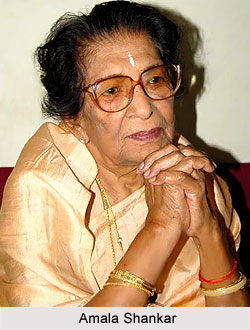Amala Shankar was born and raised in Kolkata in the state of West Bengal in the year 1919. She comes from a cultured Bengali family and right from her childhood she lived a simple life and always possessed an aesthetic outlook, having immense attraction towards ancient scriptures and literatures. She later on became a renowned classical dancer in India and the driving force behind Uday Shankar India Culture Centre as a teacher and trainer of the dancing trouped that toured the world.

Early Life of Amala Shankar
Born as Amala Nandy in June 1919, in the Batajor Village of Magura District (presently in Bangladesh), Amala Devi was raised in a culture that was close to village life and nature. It was only obvious for her to feel drawn to different forms of art as a child. At the age of eleven she along with her father went to International Colonial Exhibition in Paris. It was in Paris that she met Pandit Uday Shankar and his family. She travelled all across Europe for a year and finally joined Uday Shankar`s dance troupe in 1931.
It was in 1939 when Amala Devi was staying in Chennai to perform at a dance by Uday Shankar dance troupe, Uday Shankar proposed to her. The couple finally tied knot in the year 1942. Amala Shankar and Uday Shankar became proud parents to a boy and girl.
Dancing Career of Amala Shankar
Amala Shankar became a proficient Indian classical dancer and also a well-versed in Classical ballet. Uday Shankar and Amala Shankar was a popular dance couple for a long time. They both appeared in an Indian Hindi language film named “Kalpana†that was based on performing arts. Released in 1948, the film was written, co-produced and directed by Uday Shankar. Amala played the character of Uma in Kalpana. She later attended the 2012 Cannes Film Festival where the film was screened.
Amala Shankar`s name spread very quickly as she was endowed with exquisite conception, poise, sense of rhythm, and expressive gesture. In 1965Amala Shankar, along with her husband Uday Shankar decided to open Uday Shankar India Culture Centre in Kolkata which was a centre for performing arts. Named after Uday Shankar`s Almora centre for dance, Amala Shankar headed the dance centre as the Director-in-Charge from the day of its inception. The legendary dancer Uday Shankar`s art of teaching was followed and developed in this school by Amala Shankar who successfully ran the school and also trained dance troupe for next 50 years.
The dancing school at Uday Shankar India Culture Centre continued until 2015, remaining dedicated in carrying forward the legacy of Uday Shankar"s ideas, processes, and innovation in creative dancing. Uday Shankar India Culture Centre offered training in classical dances like Kathakali, Bharata Natyam, Manipuri, Kathak, and Odissi.
Later life of Amala Shankar
As a tribute and to pass to on the legacy of her husband after his death, Amala Shankar worked hard to showcase to the world the exquisite choreography of Shankar, as well as new innovative dance forms created with help of Guru P. Raghavan and her team of dedicated musicians. Under her tutelage, the performing troupe of Uday Shankar India Culture Centre toured widely through the world and within India, with the support of Government of India and private funding bodies.
Amala Shankar recreated major productions and dances of Uday Shankar, such as Samanya Kshati, Mahamanav – shadow play, Labour and Machinery. She re-staged her husband"s choreographies of dances like Snanam, Village Festival, Kartikeya, Astra Puja, and Raas Leela, among many others. Amala Shankar also created new Choreographies for Seeta Swayamvara, Yuga Chanda, Vasavadutta, Chidambara, Chitrangada, Kal Mrigaya, and many more.
As an incredible teacher following the organic path of education, Amala Shankar insisted on overall development of dancers. Her students were taught costume and stage design, apart from movement creation processes and choreography. Remaining active until her nineties, Amala Shankar"s last performance was the dance drama named “Sita Swayamvar†at the age of 92, in which she played the role of King Janaka.
Awards Received by Amala Shankar
Amala Shankar became a great Indian danseuse and an inspiring practitioner of experimental and modern Indian dance. She was awarded the Padma Bhushan in 1991. With her mission in life becoming the propagation of Shankar`s work and pedagogical process, Amala Shankar was also awarded the Banga Bibhusan by the West Bengal government in 2011. Amala Shankar`s contributions in conceptualizing, refining and creating the new age dances, stay unparalleled even today.
Personal Life of Amala Shankar
Amala Shankar and Uday Shankar has been blessed with a boy named Ananda Shankar in 1942 who later became an Indian musician, singer, and composer known for creating fusion music blending western and eastern genres. The couple of again blessed with a daughter in 1955 named Mamata Shankar who became a renowned Indian dancer and actress in Bengali cinema. Amala Shankar is the sister-in-law of the famous sitar maestro and music composer Ravi Shankar who was the younger brother of Uday Shankar.
Amala Shankar passed away in 2020 at the age of 101. She was suffering from age-related ailment and succumbed to cardiac arrest. Today, in the absence of Uday Shankar and Amala Shankar, the legacy of “Shankar Gharana†continues through her, her daughter Mamata Shankar and daughter-in-law Tanushree Shankar.



















